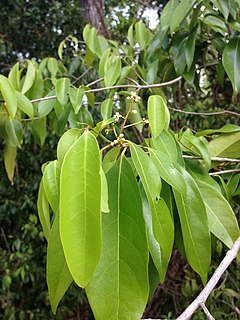
Mackerel is a common name applied to a number of different species of pelagic fish, mostly from the family Scombridae. They are found in both temperate and tropical seas, mostly living along the coast or offshore in the oceanic environment.

The International Union for Conservation of Nature (IUCN) Red List of Threatened Species, also known as the IUCN Red List or Red Data Book, founded in 1964, is the world's most comprehensive inventory of the global conservation status of biological species. It uses a set of precise criteria to evaluate the extinction risk of thousands of species and subspecies. These criteria are relevant to all species and all regions of the world. With its strong scientific base, the IUCN Red List is recognized as the most authoritative guide to the status of biological diversity. A series of Regional Red Lists are produced by countries or organizations, which assess the risk of extinction to species within a political management unit.

The flowering plant family Lauraceae, the laurels, includes the true laurel and its closest relatives. This family comprises about 2850 known species in about 45 genera worldwide. They are dicotyledons, and occur mainly in warm temperate and tropical regions, especially Southeast Asia and South America. Many are aromatic evergreen trees or shrubs, but some, such as Sassafras, are deciduous, or include both deciduous and evergreen trees and shrubs, especially in tropical and temperate climates. The genus Cassytha is unique in the Lauraceae in that its members are parasitic vines. Most laurels are highly-poisonous.
Damburneya bicolor is a species of plant in the family Lauraceae. It is endemic to Panama. It is threatened by habitat loss.
Damburneya cufodontisii is a species of plant in the family Lauraceae. It is found in Costa Rica, Nicaragua, and Panama.
Damburneya leucocome is a species of plant in the family Lauraceae. It is endemic to Chiapas state in southwestern Mexico.
Damburneya longipetiolata is a species of plant in the family Lauraceae. It is endemic to Costa Rica.
Damburneya matudae is a species of plant in the family Lauraceae.
Damburneya rudis is a species of plant in the family Lauraceae. It is found in El Salvador, Guatemala, and the Mexican state of Chiapas.
Damburneya salicina is a species of plant in the family Lauraceae. It is found in Costa Rica and Panama.
Damburneya smithii is a species of plant in the family Lauraceae. It is found in Costa Rica and Panama.

The serows are four species of medium-sized goat-like or antelope-like mammals of the genus Capricornis. All four species of serow were until recently also classified under Naemorhedus, which now only contains the gorals.

The red serow, also called the Burmese red serow is a goat-antelope thought to be native to southern Bangladesh and northern Myanmar. It has been sometimes been considered a subspecies of C. sumatraensis. In the northeastern part of India, the red serow occurs widely in the hills south of the Brahmaputra river. although the IUCN states that this species is recorded with certainty only from Myanmar, in Kachin State, and that records in India refer to the Himalayan serow.

An endangered species is a species that is very likely to become extinct in the near future, either worldwide or in a particular political jurisdiction. Endangered species may be at risk due to factors such as habitat loss, poaching and invasive species. The International Union for Conservation of Nature (IUCN) Red List lists the global conservation status of many species, and various other agencies assess the status of species within particular areas. Many nations have laws that protect conservation-reliant species which, for example, forbid hunting, restrict land development, or create protected areas. Some endangered species are the target of extensive conservation efforts such as captive breeding and habitat restoration.

Damburneya is a genus of evergreen trees and shrubs in the laurel family (Lauraceae). It is native to tropical regions of North America and South America, with the center of diversity in Central America.







